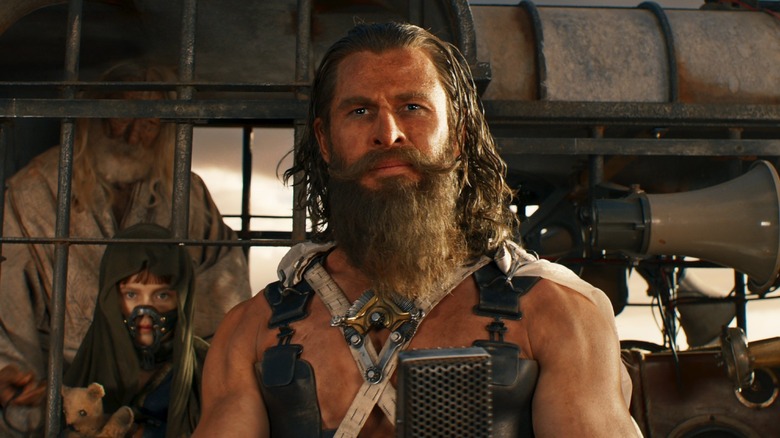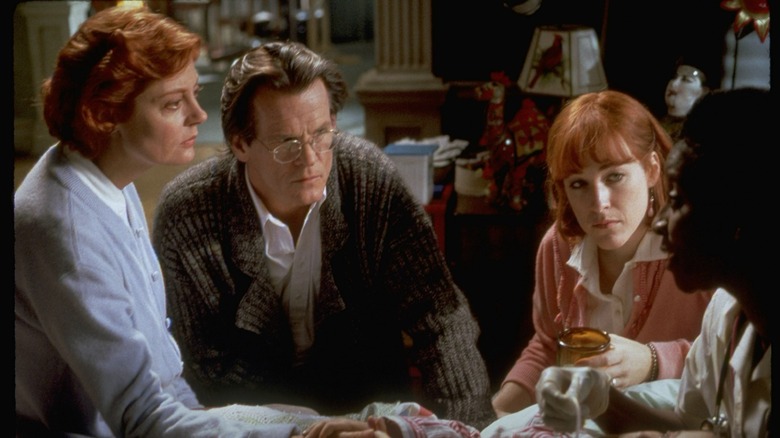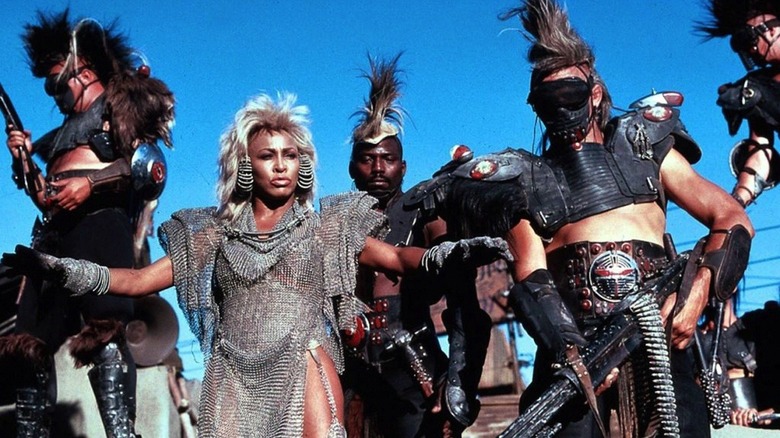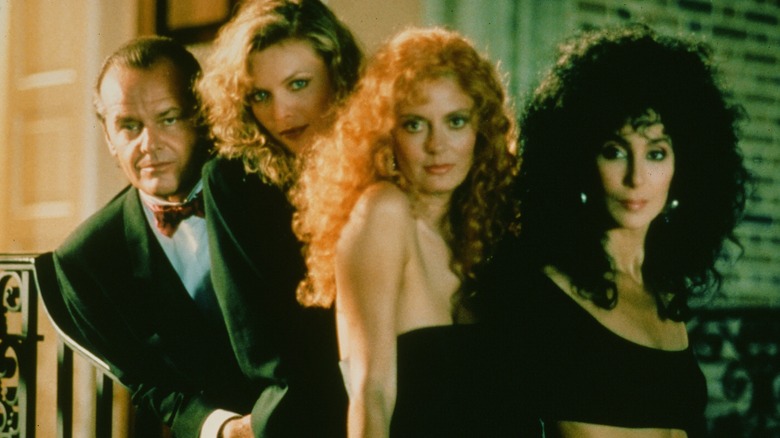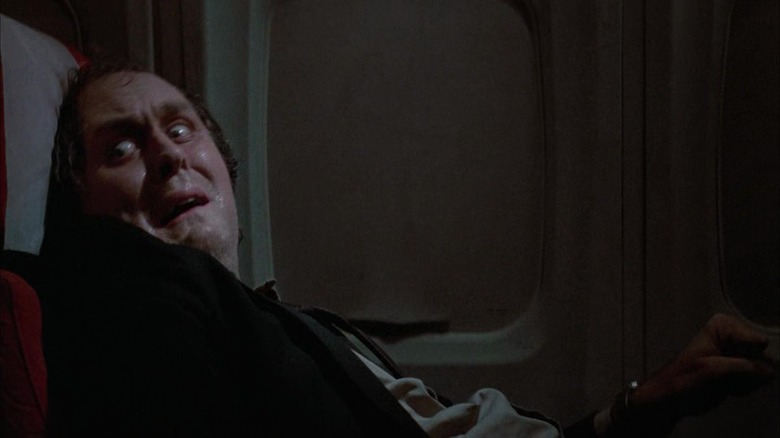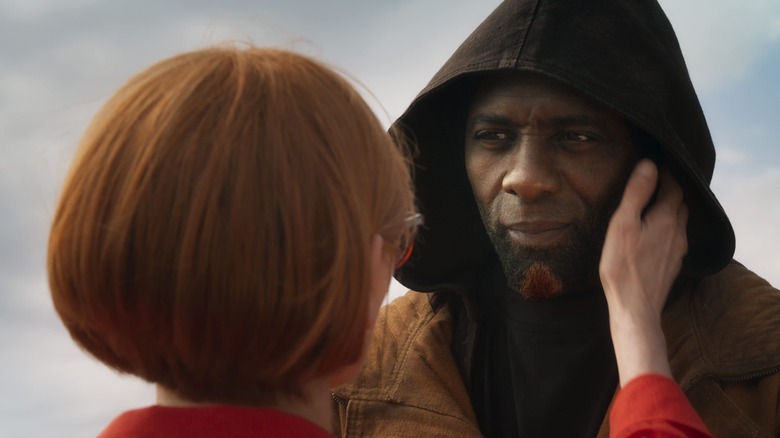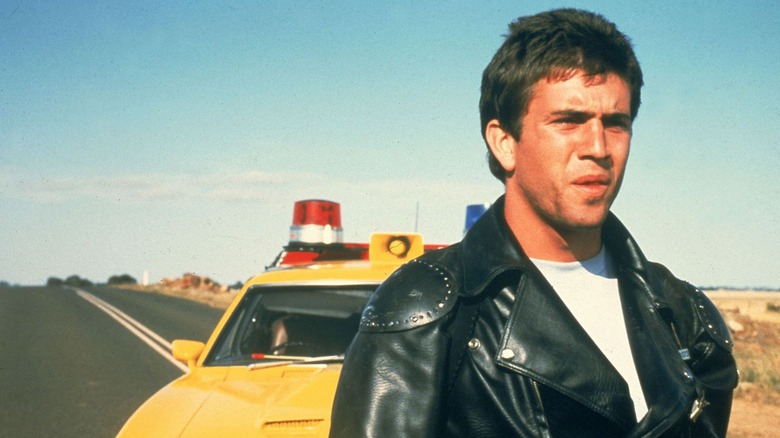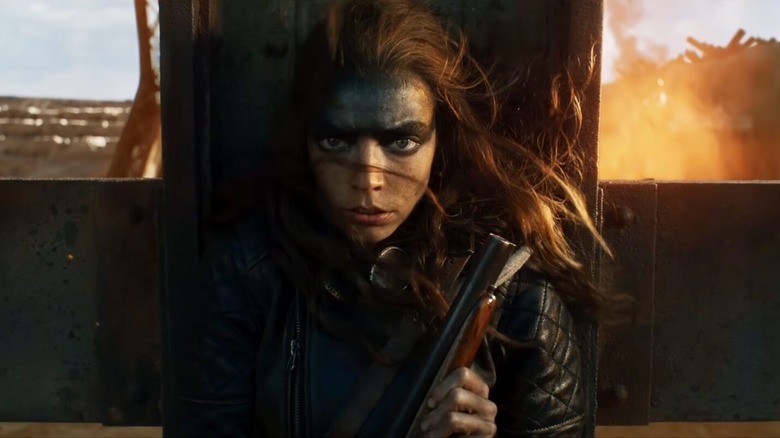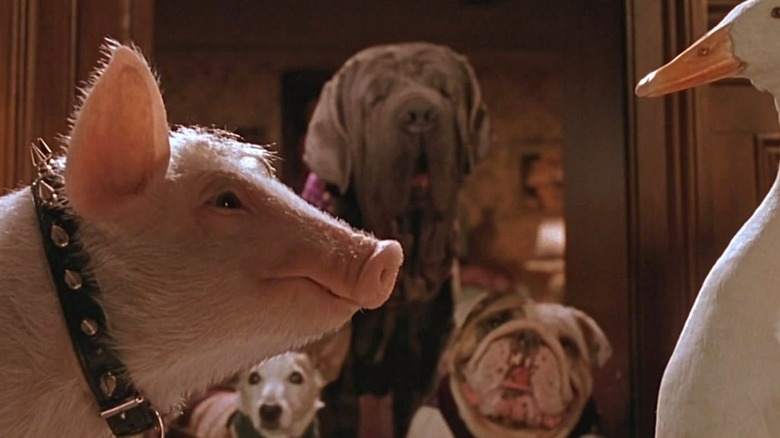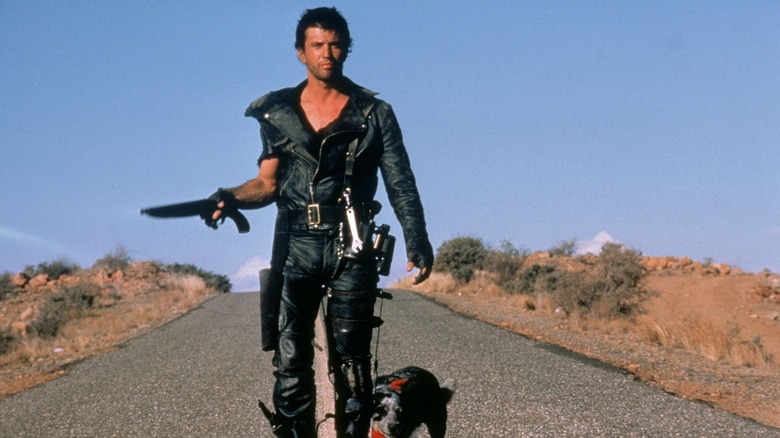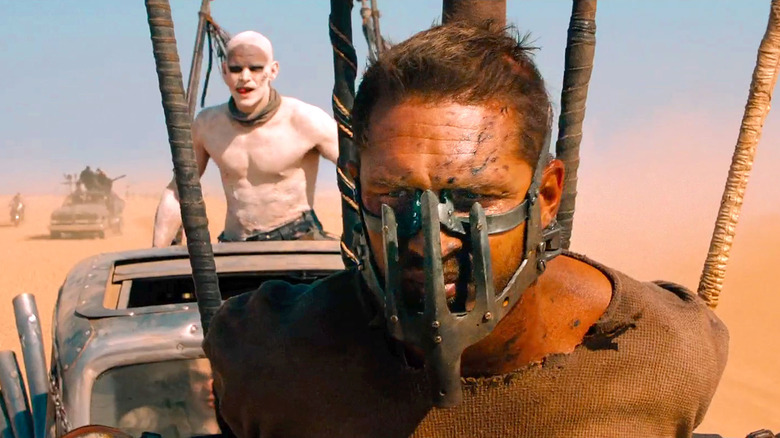The Films Of George Miller, Ranked
One of George Miller's films, "Lorenzo's Oil," opens with an epigram reading as follows: "Life has meaning only in the struggle. Triumph or defeat is in the hands of the Gods ... so let us celebrate the struggle!" Celebrating the struggle may seem paradoxical in life or in cinema, but that concept runs through just about every one of Miller's films, created over the course of four decades. From post-apocalyptic action fantasies to deliriously twisted family fare, Miller has never been too boxed in with the films he's made. Through his filmography, George Miller has done everything from introducing one of cinema's biggest action stars to depicting a sea of penguins dancing to pop music. As weird as those extremes may be, it somehow all makes sense. With the arrival of Miller's latest entry in the "Mad Max" franchise, "Furiosa," in theaters now, let's rank all of Miller's films.
12. Happy Feet Two
It is no less baffling today than it was in 2011 that George Miller directed two different computer-animated films that feature penguins singing and dancing to modern music. "Happy Feet Two" didn't capture the imagination of the collective audience the way the 2006 original did, even though the concept and much of the cast are the same. Now, the tap-dancing Mumble is trying to get his shy son to burst out of his shell while avoiding the dangers of climate change that aim to destroy his family's home. "Happy Feet Two" is also the story of two krill, one of whom wants to jump up a few rungs on the food chain while his buddy wants to maintain the status quo. As baffling as the B-story is, it's almost more so when you realize the two krill are voiced by Brad Pitt and Matt Damon, respectively. "Happy Feet Two" isn't much worse than its predecessor, with a very game A-List cast, but the story never leaps beyond its strange setup and fails to display the kinetic energy Miller effectively created in his live-action fare.
11. Happy Feet
The 2006 original does have a bit more kinetic energy on display than the ensuing sequel. Part of that sense is the fact that "Happy Feet" has to set up as part of its overall premise that Mumble (voiced by Elijah Wood) is a gifted tap dancer — courtesy of real-life moves from the iconic Savion Glover — and that the penguins of this world all have a vast knowledge of modern music. (Why do they consider humans to be "aliens" if they also know the music of Elvis Presley?) The film also has twists that were more jarring and unexpected initially, such as introducing live human actors into crucial moments (a couple of years before Pixar did the same with its 2008 film "WALL-E"). While both films feature commentary against the scourge of climate change, it's more timely and impassioned in the original.
But for all the hints of an edgier story, this is still a movie where penguins sing and dance to pop music, and that choice gets less charming and more like a studio mandate with age. At the time, "Happy Feet" made enough of a splash that it won the Best Animated Feature Oscar (over Pixar's own "Cars," talking about films whose premises are flimsy if you think about them for more than a minute), but it hasn't aged quite as well as some of Miller's other films.
10. Lorenzo's Oil
"Lorenzo's Oil" is a film that reunites Miller with one of the lead actresses from a film we'll discuss later on in this list. You can be forgiven for not knowing the film too well; in many ways, it's the truest outlier in the director's career. It has no genre trappings, very little humor, and is arguably the most depressing film he's ever made. (That's in spite of the fact that Miller's most famous films are set after a worldwide apocalypse.) "Lorenzo's Oil" is based on the tragic true story of the Odone family, as parents Augusto and Michaela (Nick Nolte and Susan Sarandon) try to solve the unsolvable when their young son Lorenzo is diagnosed with a rare brain disease that is all but guaranteed to kill him in two years.
"Lorenzo's Oil" does still feel very much like a George Miller film in its operatic camerawork (from cinematographer John Seale), in its big emotional swings (such as Nolte's very aggravated Italian accent work), and in its overall performances. Many moments in which Lorenzo's agony is depicted are roughly as nightmarish as the more terrifying aspects of a "Mad Max" film, even if this story is firmly grounded in the real world. While it's easy to sympathize with the Odone family, their stubborn refusal to listen to medical professionals who don't give them the answers they want to hear rings a bit differently in a post-COVID-19 world. (The eponymous oil prolonged Lorenzo's life well beyond expectations — he died at age 30 — but was less successful for other patients with similar diseases.) "Lorenzo's Oil" is a fascinating film, in and of itself, boasting a remarkable, Oscar-nominated performance from Sarandon. But as curious an entry as it is in Miller's filmography, it's not quite a successful one.
9. Mad Max Beyond Thunderdome
It's still a "Mad Max" movie, so it can't be a huge swing and a miss, but "Mad Max Beyond Thunderdome" is a less effective film (in spite of having an admittedly very, very cool title). Arguably the best action sequence of the film takes place not beyond Thunderdome, but literally within it, as Max Rockatansky (Mel Gibson, in his third and final go-round as the laconic and twisted sci-fi hero) is forced to fight the monstrously large Blaster for his freedom. Though that fight sequence doesn't end in death, as hoped for by Auntie Entity (Tina Turner), the overseer of Bartertown, it's cleverly staged and designed.
Elsewhere, "Beyond Thunderdome" is primarily notable for the aforementioned Turner, who was arguably a much bigger name at the time than Gibson. (The controversial ex-A-Lister wasn't even 30 when "Beyond Thunderdome" was released in 1985, and was two years away from starring in the first "Lethal Weapon.") Aside from that, "Beyond Thunderdome" is a less complex film, offering a less impressive array of action. At the time, Miller was reeling from the loss of his producing partner Byron Kennedy, meaning the film was co-directed by George Ogilvie, which may also explain the weaker cumulative effect of this entry.
8. The Witches of Eastwick
While Mel Gibson became a star in part because of the "Mad Max" films, the first time that George Miller worked with already-established stars was with his first full-length American feature. An adaptation of the popular John Updike novel of the same name, "The Witches of Eastwick" has a high enough concept — in which a trio of modern women band together, realizing they're genuine witches, and fight off the Devil in human form — before you add to the mix the presence of Sarandon, Michelle Pfeiffer, and Cher as the three witches, and Jack Nicholson as Daryl Van Horne. "Eastwick" is tonally all over the place, with moments of outrageous and low comedy, special-effects-driven setpieces, moderately erotic touches (since in the early going, all three women are seduced by the Devil), and interpersonal drama. With that description in mind, it's not surprising that "Eastwick" is not always successful. Even in spite of the various plot machinations, Miller's own style is battling at times with some of the performers, whose work is so outsized that they dominate the proceedings. Nicholson being cast as the Devil is almost ... well, too obvious, but he's undeniably fun to watch even if it's a relatively one-note performance. "Eastwick" is perhaps not going to age very well as a treatise on gender issues in the year of our Lord 2024, but its visceral charms are worth noting.
7. Twilight Zone: The Movie
On one hand, this may seem like cheating. While "Twilight Zone: The Movie" is a feature film, it's an anthology feature with four different directors filming four different shorts in the vein of Rod Serling's seminal science-fiction TV series. In the summer of 1983, when the film was released, Miller wasn't as big of a name as at least two of the other directors, John Landis and Steven Spielberg. Yet although Landis' section of the film made world news for very different and tragic reasons, it was Miller and his fellow director Joe Dante who created vastly superior pieces of filmmaking. Miller closed out the film with his remake of "Nightmare at 20,000 Feet," in which an already nervous flier (John Lithgow) is unable to convince his fellow passengers that a monstrous gremlin is on the outside of the plane destroying it piece by piece. The story is tense enough, but Miller went hog-wild in depicting the flier's increasing mania, full of fast-paced edits, tight close-ups, and Lithgow's own committed and (often literally) sweaty work. Though his section of "Twilight Zone: The Movie" is not a feature in and of itself, Miller's direction is unmistakable and the cumulative effect is enough to surpass the classic original episode (starring William Shatner). And anytime you can out-direct Steven Spielberg, it's worth celebrating.
6. Three Thousand Years of Longing
That George Miller can take years between his projects is as much a representation of how hard it is to get them off the ground as it is a sign of his unique tastes. While it may initially strain credulity that the first film he made after "Mad Max: Fury Road" was a paean to the power of storytelling as evidenced by the strange and tender relationship between an academic and the genie she inadvertently unleashes, it also makes perfectly twisted sense. "Three Thousand Years of Longing" has two warring energies. On one side, there are the two-hander scenes wherein the academic (Tilda Swinton) and the genie (Idris Elba) get to know each other. In these talky stretches, the genie weaves a few different stories to explain how he became a genie at all, and why his lamp had been lost to the passing of time.
On the other side, there's the depiction of the genie's stories, which are full of the lively color, unique design, and visceral FX work that we may associate with Miller's past films. "Three Thousand Years of Longing" works less for those traditional hallmarks and more for the lively chemistry between Swinton and Elba, who light up the screen even if the material they work with is slightly more hit-and-miss. If nothing else, it remains impressive that Miller got away with this one, precisely because of how different it is from the modern classic that re-established his bona fides.
5. Mad Max
Just as it's a little hard to believe that George Miller ever managed to make a big-budget action epic like "Mad Max: Fury Road," it's a little hard to believe that a massive franchise kickstarted with a debut picture like this one. "Mad Max" introduced the world to Mel Gibson, and like other Australian genre fare of the 1970s and 1980s, it wasn't screwing around. When we meet Max Rockatansky in the 1979 original, the world has not gone completely insane, but it's getting close. Max is married and has an infant son when the film begins, but by the time the credits roll, he's the hardened loner driven to insanity because marauding biker gangs have not only attacked him but killed his family. The devastation wrought by oil and water shortages across the world (or at least across Australia) almost pales in comparison to the losses Max has. Though Max's subsequent vigilantism may recall American action films like "Death Wish," those films do exist in a version of the real world, not a dystopic vision of what the world may become soon, adding to the strange and haunting quality of the original "Mad Max." Fitting, though, that George Miller's debut felt like a warm-up to the real action that would lie ahead for Max.
4. Furiosa: A Mad Max Saga
Take heart: while "Furiosa" is (in this writer's opinion) not the best "Mad Max" film, it's still an impressive and powerful film to behold. If there lies any issue with the 148-minute epic, it's the simple fact that if you know "Mad Max: Fury Road," you have some general sense of where this story would have to be going. From "Fury Road," we know that Furiosa works for the disturbing Immortan Joe and has for some long stretch of time. We know she has one arm, and we know that she's looking for the Green Place of her childhood. When "Furiosa" begins, the heroine is still a child (Alyla Browne) with two functioning arms and is kidnapped from the Green Place by marauders and delivered to the twisted warlord Dementus (Chris Hemsworth). There are plenty of twists and turns in Furiosa's story, but only so many. (It's not like Hemsworth made an appearance in "Fury Road," for example.)
"Furiosa," as its subtitle implies, is more sprawling than "Fury Road," replete with chapter titles, a bigger cast, and a slightly less focused narrative. Miller and co-writer Nico Lathouris deliver some of the goods you might hope for from a film so directly connected to the 2015 classic. (The third chapter, which takes up about 20 minutes in the middle of the film, is a pitch-perfect action sequence that recalls the first major chase scene in the War Rig in "Fury Road.") One of the strangely unexpected twists of this film is that much like how "Mad Max: Fury Road" ended up putting its title character to the side, "Furiosa" relies much more on Browne's and Taylor-Joy's eyes to communicate, in some ways making the title character feel like a side player. (Taylor-Joy doesn't appear for roughly the first hour, and she only has a few handfuls of lines of dialogue throughout.) Though it's a little less polished, "Furiosa" still feels as jaw-dropping at times as "Fury Road," often making you wonder how the hell Miller (who's pushing 80) was able to pull this film off.
3. Babe: Pig in the City
George Miller was (officially) just a producer for the 1995 family film classic "Babe," which garnered a handful of Oscar nominations including one for Best Picture. (Coincidentally enough, "Babe" lost out to Miller's old collaborator Gibson, with his period epic "Braveheart.") There was always some controversy about how much of the original may have belonged truly to its credited director Chris Noonan as opposed to Miller, but if the distinctive, oddball, and unexpected "Babe: Pig in the City" is any indication, Miller only truly directed this 1998 sequel. Though a book served as the source material for the original film, "Babe: Pig in the City" simply takes its chipper title character on an entirely new adventure that feels moderately reminiscent of the "Mad Max" series in its conglomeration of inspirations — the city is a production-design gumbo with influences from Oz to New York City to Sydney to Chicago — and in its madcap and unexpectedly dark tone. Though most critics were baffled by the film, and audiences didn't show up in droves this time, "Babe: Pig in the City" is the one older film of Miller's that has aged extremely well relative to its initial reputation.
2. The Road Warrior
Whether you call it "Mad Max 2" (the original Australian title) or "The Road Warrior," this second film featuring Max Rockatansky was as much of a calling card for both Miller and Gibson as its predecessor was. This 1981 film also established what has now become the standard arc for a "Mad Max" movie. Whereas the original is set at a time when the world is teetering into widespread chaos, this one is in the thick of the post-apocalypse, with the wandering Max aiding a group of settlers against some nasty villains with uniquely daffy names. Miller doesn't always need to work at a stripped-down volume (as our number-one title implies), but "The Road Warrior" is still a low-budget action film that created rip-roaring setpieces out of very little. The combination of Gibson's live-wire performance, portending his work in the "Lethal Weapon" series, and Miller's manic energy in staging low-budget action that felt bigger than what Hollywood could craft, make "The Road Warrior" a special film that transcends the grim trappings of post-apocalyptic storytelling.
1. Mad Max: Fury Road
The 2015 action epic "Mad Max: Fury Road" does not have an overly complex plot, and it remixes concepts from the Gibson-starring trilogy. The actors are different, and the base premise may be the same, depicting a post-apocalyptic nightmare vision of Australia in which Max (Tom Hardy) struggles to survive let alone maintain his own code of justice. Max is quickly captured at the start of "Fury Road" by War Boys who live at the Citadel, overseen by the cultish tyrant Immortan Joe. But Max's arrival dovetails with the fearsome Imperator Furiosa (Charlize Theron) helping Joe's five brides escape to a mythical Green Place, and the ensuing chase encompasses ... well, the majority of the film.
Filmmakers like Steven Soderbergh are as in awe of "Fury Road" as the rest of us are, simply because it defies description that this movie even exists. The familiarity of the premise is vastly outweighed by the awe-inspiring work on display, through practical and digital FX, death-defying stunts, and more. Though Theron, just like Taylor-Joy, has not been shy about discussing the challenging experience of making "Fury Road," the end result is one of the most incredible action films ever made. The War Boys demand to be witnessed before sacrificing themselves for a perceived greater good. "Fury Road" is George Miller demanding that the rest of us witness him offer a sacrifice to the cinema gods. It's a hell of a thing.
